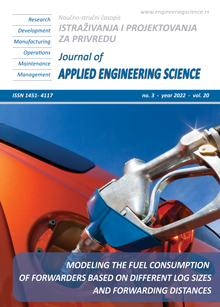PLANNING AND EXPERIMENTAL STUDIES OF SELECTION THE OPTIMAL WELDING MODE BY THE FRICTION OF FITTING RODS
Abstract
The methods of friction welding of various materials have been studied, as well as the design and capabilities of the device for friction welding have been determined. The design of the device for friction welding on the basis of a lathe has been developed taking into account the established requirements and recommendations of machine-building enterprises. To study the influence of technological factors on the quality of welded joint formation, a full factorial experiment (FFE) of type 22 was set up according to the plan. The adequacy of the planned experiment was confirmed by calculations (Fcalcul. = 1.1 <Ftabl. = 4.46.) on the basis of which a full-scale experiment was carried out. According to the results of the experimental plan, it was found that the heating time of the workpieces being welded has the most significant effect on the total length of the seam upsetting. The optimal mode with the correct formation of the burr has been chosen. The convergence of the full-scale test results with the planning of the Type 22 full factor experiment has been identified, resulting in the determination of the optimal mode.
References
Yessirkepova, A., Sherov, K., Buzauova, T., Mikhailov, V., Mazdubay, A., Taskarina, A. (2020). Research of ways of connecting reinforced bars in the production of reinforced concrete products. Journal of Applied Engineering Science, vol. 18, no. 3, 372 – 377, DOI:10.5937/jaes18-24319.
Rama, R., Kiran K., Sai K. (2015). Design and Fabrication of Rotary Friction Welding on Lathe Machine. National conference on Developments, Advances & Trends in Engineering Sciences. p.20-24. http://www.ijera.com/special_issue/NCDATES/MECH/PART-3/ME%20126-2024.pdf.
Jagroop, S., Karamdeep, S. (2014). Fabrication of Friction Welding on Centre Lathe: A Case Study. International Journal of Research in Mechanical Engineering & Technology. p.145-147. http://www.ijrmet.com/vol4issue2.2/29-Jagroop-Singh.pdf.>
Gourav, S., Ajay, L. (2013). Friction Welding on Lathe Machine with special Fixture. International Journal of Innovations in Engineering and Technology, p.258-261. http://ijiet.com/wp-content/uploads/2013/07/41.pdf.
Shah, K., Khurshid, H., Ul, H., Khurshid, N., Ali, Z. (2021). Conversion of a Conventional Lathe Machine into a Friction Welding Machine and Performing Some Experimental Tests for its Operational Feasibility. Mehran university research journal of engineering and technology, vol. 40, no. 3, 545-555, DOI 10.22581/muet1982.2103.09.
Buzauova, T., Bahtybai, I., Mateshov, A. (2019). Analysis of the existing device and method of friction welding based on a lathe. Materials of the international scientific and technical conference “Innovative machine-building technologies, equipment and materials”, Part 2, p. 215-218.
Sherov, K., Yessirkepova, A., Imanbayev, Y. Gabdysalyk, R., Buzauova, T. (2020). Friction-welding device based on lathe machine. Patent No. 4676 of the Republic of Kazakhstan for utility model.
Buzauova, T., Bahtybai, I., Sivachenko, L.A. (2022). On the Development of the Design of a Device for Friction Welding of Dissimilar Materials on the Basis of a Lathe. Universitet Enbekteri – University Proceedings, no. 2(87), 25-30. DOI 10.52209/1609-1825_2022_2_10.
Spirin, N., Lavrov, V., Bondin, A., Lobanov, V. (2003). Methods for planning and processing the results of an engineering experiment. GOU VPO UGTU-UPI. Ekaterinburg.
Spiridonov, A. (1991). Planning an experiment in the study of technological processes. Mashinostroenie, Moscow.
Bolshev, L., Smirnov, N. (1983). Mathematical statistics tables.Science, Moscow.

